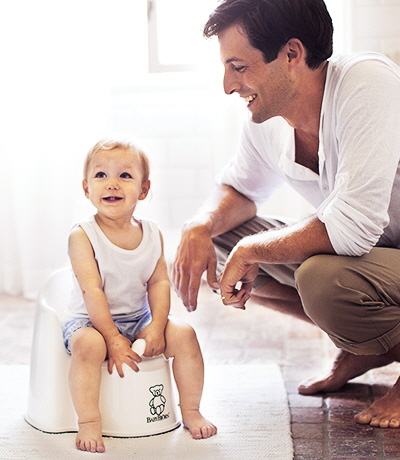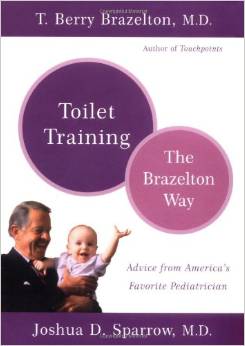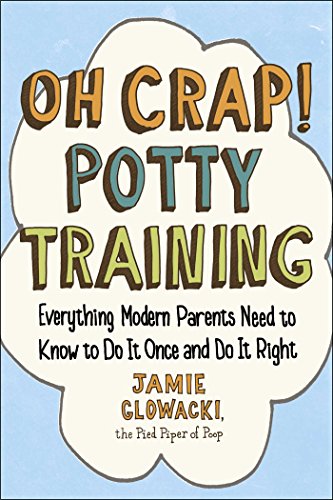Potty Training Methods: The Best of List
Potty Training Readiness
First off, is your child ready? Many parents are unsure.
Physically speaking, your kid has to be able to walk (run?) to the potty, sit down on her own and pull her pants down (more or less), follow simple commands, and understand and communicate potty words, either verbally or through sign language.
It also helps if she can keep a diaper dry for at least 90–120 minutes, a sign that her bladder muscles are under control of her brain, rather than contracting reflexively—as happens in infants, and if she no longer poops in the middle of the night.
The 3 Main Methods for Potty Training
There are three main potty training methods (more or less), although most people don’t use these terms. Here are the highlights of each:
I. The Brazelton or Child-Oriented (CO) Approach
Dr. T. Berry Brazelton introduced his child-oriented (CO) approach in 1962 after he had observed an increase in toilet training failures, including toilet refusal and severe constipation. He suspected that many parents were pushing kids to toilet train before they were ready and recommended that parents delay toilet training until the child shows signs of readiness.
With Brazelton’s method, you follow a series of steps as you observe the readiness signs. Before beginning each step, you must wait until your child shows interest. There is no schedule or timeline to follow; the child sets the pace.
Step 1) Kid meets the potty and sits on it, fully clothed (isn’t this fun? Yay!) ~ Usually around 18 months or so. If that goes well…
Step 2) Kid sits on the potty with pants and diapers off and is praised—though not TOO heartily, some experts warn, as that can build pressure—if he goes. If that works out okay…
Step 3) Kid is put on the potty after he soils his diaper and the contents of the diaper are emptied into the potty; parent explains that poop and pee go into the potty. Later…
Step 4) Kid goes diaperless for short periods of time and is encouraged to use the potty independently.
If during this process, the child ever resists the potty, the parent is supposed to immediately stop training for one to two months and then start over again.

The CO (child-oriented)/Brazelton approach, endorsed by both the American Academy of Pediatrics and the Canadian Paediatric Society, seems to be effective if started between 18 and 24 months of age. BUT, parents should be prepared for the training duration to last until the child is approximately three years of age.
Pros:
There is no pressure on the child or the parent, parents can train at their leisure, there’s no big commitment on anyone’s part (clearing your schedule for a weekend and whatnot).
Cons:
It can take a really long time until total training is complete – from start to finish. Research suggests that it can take 6 to 18 months, depending on when you begin. This means parents (and kids) can get burned out.
Also, it’s an awful lot of work (total hours from start to finish) without any reliable results. The biggest risk is that your child learns that going on the potty is an optional thing – and never really takes it very seriously. Then, when you are ready to get serious about it (preschool starts next month, crap!), it’s much harder because the inconsistency of this approach has undermined the process.

II. The Two-Day (or 3-Day) Method
This method was originally developed in the 1970’s by behavioral psychologists Nathan Azrin and Richard Foxx and popularized in their best-selling book Toilet Training In Less Than A Day. Azrin and Foxx originally developed their method for children with mental disabilities, but later found it worked well with all children.
Mind you, the book is old and outdated and some of the techniques are not PC. Thus, many experts (and hacks like me, LOL) have adapted the basic concept to a modern-day approach, the most popular version of this method is detailed in the hilarious and very useful potty training book, Oh Crap! Potty Training, which I highly recommend. We also elaborate on the Two-Day method of Potty Training here.

There are many variations of this method, but the theme is the same: mom and dad clear their schedule for an entire weekend (or three-day weekend, even) to commit to potty training. Diapers are ceremoniously thrown away (for the daytime, at least).
During the first couple of days, the parent/s watches the child like a hawk and during this time, the child goes naked (at first) and is loaded up with fluids (many use juice as an incentive), then taken to the potty regularly – or is placed on the potty (hurry!) once they have already started – until the child connects the dots of the sensation of peeing and pooping and identifies how the urge to go feels, and ultimately, begins going on his or her own.
The child starts out naked on Day 1, then goes commando (pants, no underwear), then fully clothed (hopefully by the end of Day two or three). Depending on the age and temperament of the child, he or she can be trained in as quickly as a day or two – but most of the time, “full training” (with child fully-clothed and self-initiating) can take several days to a week or two.
This method requires commitment and planning on the part of the parents, no doubt, but is quick and effective. With this method (the original Azrin and Foxx method), a researcher reported a 74% success rate for kids under 25 months and a 93% success rate for kids over 25 months. Eight weeks after training, kids averaged less than one accident per day (Butler, 1976).
As one veteran mother put it, “Use the ‘child-oriented’ method and it’ll take a year; use the two-day method and it’ll take a week.”
There are many different variations to this technique, which we’ll discuss more in Part IV: The 3-Day Method.
Pros:
Very quick (two days – two weeks), there’s no waffling back and forth and sending mixed messages, very effective, can be done as young as 20 months.
Cons:
Requires parents to clear their schedules for one weekend – and perhaps limit outings in the next few days that follow, there’s more pressure on the child (vs. the CO method), failure can be a big disappointment, parents need to prepare for it in advance.
This is the technique I used for both of my girls around 30 months (2.5 years) – before I researched any of this or even knew what it was called (I read a blog post from a friend), and it worked beautifully. Thus, I am admittedly biased.
III. The Self Potty Training Approach
Letting your child train himself is exactly how it sounds. Essentially, you wait until your child expresses interest to go on the potty (usually as a result of mimicking peers, older siblings, etc.) – and the rest is history. Because the child is self-motivated, the actual training is quite fast and easy.
This is the daydream of every parent, no? The bad news is that, with most children, it’s exactly that: a daydream. While I do know of this happening with a few children – mainly little girls between two and three, many will never get there. But by the time children are three or four, they are SO used to going in their diaper, changing their habits is even harder.
Pros:
There’s no fuss, no pressure, no bribery, no anything, really. It all happens naturally.
Cons:
Waiting for your child to get to this point can take a really long time, especially for boys. This technique seems to be more effective for kids who have older siblings or role models to mimic and for boys for whom other methods of training have failed (hence, the parents don’t really have a choice in the matter).
For many children who are starting preschool (at the age of three or four) or who wish to participate in other childcare programs where toilet training is a requirement, waiting for this to happen on its own isn’t possible or practical.
That said, I don’t know any child (although I’m sure they exist) who enters Pre-K (as a young four-year-old) who isn’t potty trained. By this age, the sense of peer pressure and embarrassment is a real thing and few children will want to be the only kid in the class in diapers (if they even allow it, which they probably don’t). Hence, you can think of four as the worst case scenario in terms of the latest age for training, although you do read horror stories of five-year-olds who will only poop in a diaper. And for children with developmental delays, it can, of course, take longer.
So, what’s the “best” approach for toilet training your kid? I think it depends on your temperament as a parent and the temperament of your child. If you think you and your child are ready and you want to get it done, try the two-day method. If, on the other hand, you want to skip the potty boot camp weekend, go with Brazelton’s method.
Everyone will get there in time, I promise.
What if My Toddler Refuses to Poop?
Pooping on the potty is a big deal.
One out of every five kids in the middle of potty training temporarily refuses to poop in the potty, a behavior clinically referred to as “stool toileting refusal.”
Why do kids get weird about pooping?
“First, all your child has ever known is the feeling of poop right up against his body. Second, as he sees it, no one has ever paid much attention to this very primal, very private function before today. Third, pooping while standing up or squatting is far more natural than pooping while sitting. Fourth, going from pooping in a diaper to pooping in a potty can be freaky as hell.”
“If you think of the diaper as your child’s oldest and dearest security blanket, the poop problem makes sense. In essence, I don’t think it’s the pooping ITSELF that is the problem; I think our children are clinging to the literal security blanket of something (the diaper) that they’ve known since birth.”
Potty Training Expert Jamie Glowacki
Furthermore, it seems to me that pooping is an emotional thing for many children. Meaning, they like the fact that they have control over their poop and feel some sense of ownership over it (gross, right?).
But it’s true! And pretty normal.
Some children may even poop in their diaper and refuse a diaper change. Yes, they become very attached to their poo! (It’s MINE!)
Just a little FYI — the pooping thing can add some complexity to the task of potty training.
Thank you! Great tips and very helpful.
Size 6 and size 7 diapers have been a huge life saver to me. And not because my kid trained late- he self started right at 2 and is trained now at 28 months….
But he hit 35 lbs at 18 months
He hit 42 ish at 2.
Some kids are bigger.
Your “theres that” line is fairly shamming to bigger children.
Ok, leave the size 6 diaper kids alone already.
My kiddo is 18months old today. He’s 27-28lbs but he wears size 6. They fit him better and hold more. The diaper “weight” ranges really depend on the kid’s shape and the diaper’s fit. Kids who are too young for potty training can absolutely be wearing size 6.